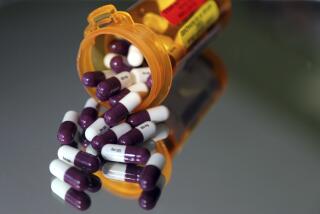U.S. Healthcare Tab Grows Faster Than the Economy
- Share via
WASHINGTON — America’s healthcare bill rose to nearly $2 trillion in 2004, or about $6,280 for every man, woman and child, a team of government economists reported today.
Healthcare spending grew faster than the output of the economy, siphoning off a disproportionate share of increasing incomes.
But the 7.9% rate of increase was a little lower than in 2003, the experts said, because some efforts to control prescription-drug costs were succeeding.
“Medical spending continues to rise faster than wages and faster than economic growth, and workers are paying much more in healthcare premiums than just a few years ago,” said the report by economists from the Centers for Medicare and Medicaid Services, published in the journal Health Affairs.
Although polls show that increasing medical costs and diminishing insurance coverage are leading concerns for voters, it’s unlikely that a Congress bitterly divided along partisan lines will succeed in any comprehensive effort to control costs or expand coverage for an estimated 46 million uninsured people.
“What you see is ongoing pressure,” said economist Deborah Chollet of Mathematica Policy Research, which conducts technical studies for government and business. “There is an agreement by most observers that the private health system is crumbling.”
The report warned: “Continued spending growth will require difficult trade-offs for businesses, households and governments as other spending also rises. These trade-offs are more stringent for those with fewer resources.”
As the government’s annual accounting of healthcare costs, the report found that spending is growing not only in dollar terms, but as a share of the economy. Healthcare represented 16% of the economic pie in 2004, compared with 13.8% in 1993 and 9.1% in 1980.
For those concerned about costs, prescription spending was a bright spot.
Americans paid $188.5 billion for prescription medications in 2004, about $14 billion more than the year before. But the 8.2% increase was the first time in a decade that drug costs have risen by less than a double-digit percentage.
The drug industry hailed the statistic as evidence that companies were not overcharging. But the report attributed the slower cost increase to a rapid rise in the use of generic drugs and mail-order pharmacies, as well as conversion of allergy and indigestion medications to over-the-counter status and safety fears that have reduced consumption of some painkillers.
Relief from increasing rates of healthcare spending may be only temporary, said John L. Palmer, one of the trustees appointed to oversee Medicare and Social Security finances.
“It’s encouraging in the sense that it is a little bit of a slowdown, but we seem to be stuck at a pretty high level of continued increases,” said Palmer, who also holds the post of university professor at Syracuse University’s Maxwell School of Citizenship and Public Affairs.
Hospital care accounted for 30% of all healthcare spending, the report found, and physician services 21%. Because hospitals and doctors represent such a big share of the healthcare marketplace, price increases for their services drive most of the overall rise in costs.
Insurance premiums increased by 8.6%, with the cost of family coverage approaching $11,000 a year. Consumers’ out-of-pocket spending grew by 5.5%, slower than the overall trend.
Two giant government programs together paid a little less than 40% of the nation’s healthcare bill. Medicare, which covers the elderly and disabled, and Medicaid, which covers a broad cross-section of low-income individuals, both grew in 2004, but Medicare spending increased more rapidly.
The report did not take into account the impact of the Medicare prescription-drug benefit, which began this month.
In a separate technical analysis, the government economists concluded that households pay about 32% of all healthcare costs, a bigger share than either employers or federal and state governments. But that calculation involved counting individuals’ Medicare taxes as healthcare costs -- something most consumers probably would not think of doing.
Economists say there is no clear limit beyond which continued growth in healthcare spending could endanger the overall economy. But it may become politically untenable to keep putting healthcare ahead of other priorities, such as education, housing and transportation.
“I don’t think there’s any magic tipping point,” Palmer said. “Whether this is sustainable politically is a different question. In all probability, there is going to have to be some political action to address these broader issues. I don’t think the political climate is such that we are ready.”
More to Read
Inside the business of entertainment
The Wide Shot brings you news, analysis and insights on everything from streaming wars to production — and what it all means for the future.
You may occasionally receive promotional content from the Los Angeles Times.










